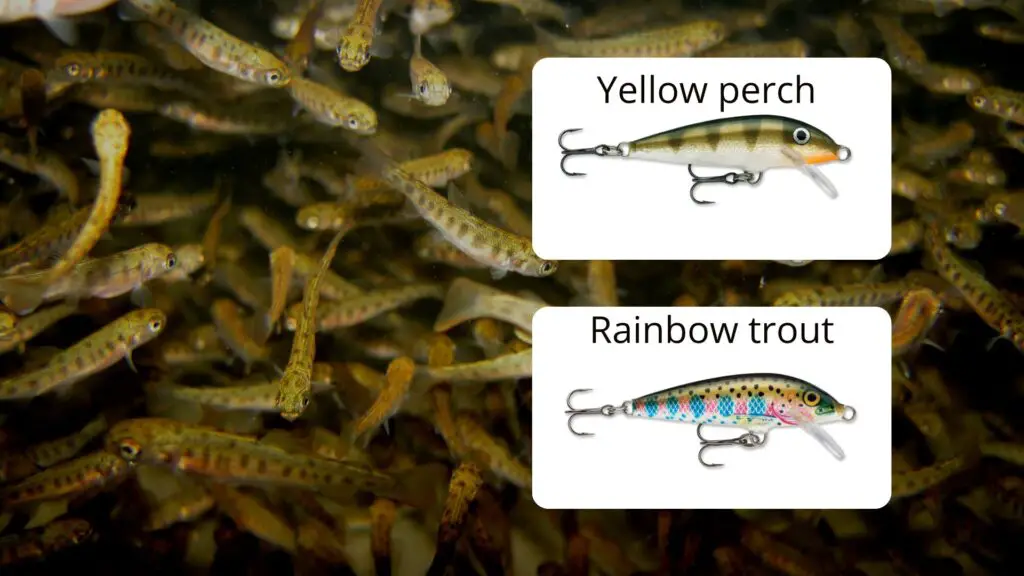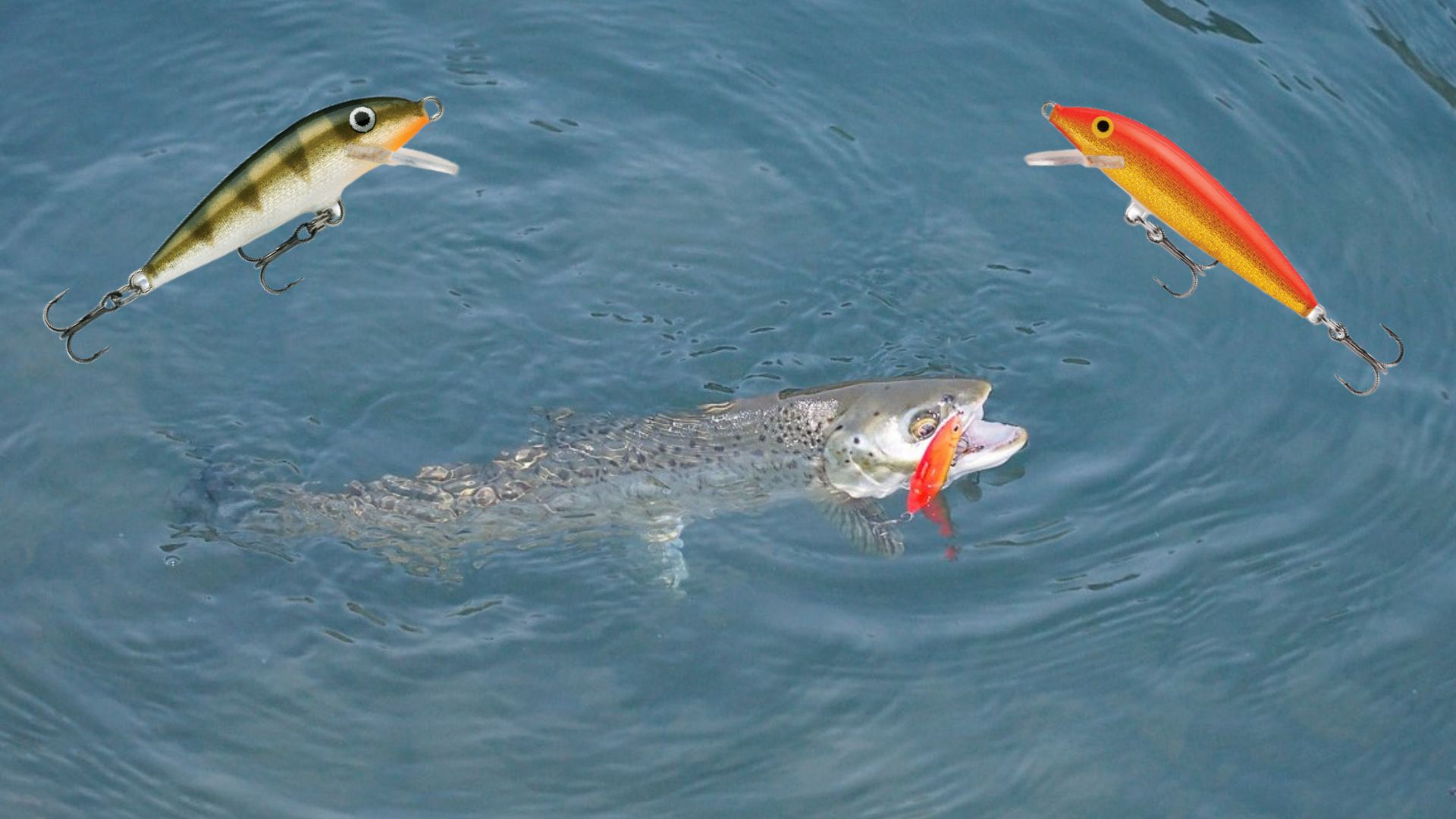Rapala lures are rated among the best trout lures. Jerkbaits like the ones from Rapala are without a doubt my favorite lure for catching mature, wild brown trout.
With over 23 Rapala patterns available. It can be difficult for newer fishermen to decide which colors to fish.
It often seems like fishermen only fish a handful of different colors, the most popular seem to be rainbow trout, brown trout, and maybe a bright option like fire tiger or chartreuse.
Sure, these three patterns cover the basics, and they do catch trout. Rapala lures, on the other hand, come in many different patterns. So there is little advantage to just limiting yourself to a few options.
So I decided to write this guide to offer some advice on selecting the best Rapala color for trout fishing. When I decide which color jerkbait I am going to fish I follow these basic guidelines.
- When the water is clear I fish natural patterns that resemble the native baitfish of the area.
- When the water is dirty I fish with contrasting bright patterns.
- I favor silvery tones in bright sunny weather
- I favor gold tones in dull cloudy weather.
- In pressured waters, I tend to avoid the most popular patterns.
Does Rapala color even matter?
Does the color of trout lures really matter? Trout have small brains and often strike out of aggression more than hunger. Surely any color combination will work?
Sometimes color does not matter. The trout are not fussy at all and will strike at anything. Other times trout seem to turn their noses up no matter what you present to them. When color and pattern matter is when the trout are willing to feed but are being a bit stubborn or highly selective.
A bright orange lure in clear water will likely spook more trout than it will catch. While a dark gray lure might not even be a trout when water conditions resemble a chocolate milkshake.
I have also witnessed occasions, where trout show a strong preference to only a small range of lures. They will strike a blue lure, but will turn down a green or yellow. It is impossible to know for sure why trout show such strong preferences. I can only speculate. Maybe it is due to the dominant color found within the natural food at that point in time, or they could have been fished over earlier in the day and are refusing colors they see as potentially dangerous.
What I certainly know, is that selecting the correct color Rapala can be the difference between a productive day on the river or going home empty handed. Yes, it requires some guesswork, but with experience and some thought, we can put the odds in our favor to increase our chances of selecting the best colors.
Start with what work previously
When fishing, it is always a good idea to rely on previous experience. Even if you have not trout fished with Rapala lures before, it is worthwhile to fall back on prior knowledge. Maybe on previous trips to a river, green kastmasters caught the most trout.
Then, I will transfer this knowledge over and start my day by fishing a green Rapala. In one of my local rivers, trout seem to love the color orange. Maybe it is confirmation bias, but if it is catching trout it does not matter.
If you are new to trout fishing and have never caught a trout before. I suggest being a bit nosy to try and figure out what other fishermen are using and that can be your starting point. I always keep a respectful eye on the competition without invading their space.
My three favorite Rapala colors?
I will share my favorite colors. They work for me in my local rivers and lakes. They are what I have confidence in fishing.
My favorite Rapala pattern resembles trout fry.
Many fishermen like to fish brown trout or rainbow trout patterns. After all, they are just a small version of a trout. So they should resemble any juvenile trout in the area.
This could not be further from the truth, these patterns resemble the adult fish coloration. This coloration simply does not occur on two inch fry.
I like the Yellow Perch pattern in clear conditions, and the plain Perch pattern when the water is a bit murky. I like these perch patterns because they have such prominent parr stripes.
Yes, there is no perch in my local waters but because of the parr making (The four vertical black stripes), they closely resemble juvenile trout fry. I find both patterns work particularly well in fisheries where there is natural trout reproduction.
My final favorite pattern is Gold Fluorescent Red.
I favor this pattern not because it looks like a domestic goldfish. But because it is extremely bright. The trout can see it in all but the murky of water.
I also will note, that trout see the color red much brighter than us. So this further enhances the visibility of the Gold Fluorescent Red pattern. I have caught a lot of good trout on this lure which many trout fishermen will automatically discount simply because it looks fake.

My thoughts on other colors
| Rapala color | |
|---|---|
| Silver Shiner Vampire Bleeding Pearl | I group these four colors together because they all represent a small, silvery baitfish. I use them interchangeably. They seem to work quite well on sandy days, in clear water conditions. |
| Yellow perch | Like I mentioned in my favorite Rapala lure section. I use these two patterns when trying to imitate juvenile trout. Yellow Perch is best in clear conditions, while Perch is best when there is less visibility. |
| Gold fluorescent red Firetiger Silver fluorescent Chartreuse Bleeding Hot olive Hot Steel | I use these bright colors when the water is dirty, and the trout will have trouble seeing. My favorite two are the Gold fluorescent red and Firetiger. |
| Gold Live Smelt Live Walleye Live Rainbow trout Yellow Perch | These five patterns are all on the gold to brown color spectrum. I find they are most effective when fished in cloudy conditions. |
| Brook trout Rainbow trout Brown trout | These three are classic trout patterns. They look like miniature versions of adult fish. All three are good generic patterns to use in clear conditions. No need to use them to target the representative species. I have caught plenty of trout on them. |
| Blue Purpledescent | I find these colors works well on bigger lakes or in deeper water. I mostly use these colors in salt water rather than for trout. |
Best Rapala Color for cloudy, dirty water?
My favorite Rapala color for dirty water is Gold fluorescent red and Firetiger. I like Gold Fluorescent Red simply due to its brightness. I like Firetiger because it is bright but comes with stripes representing parr markings.
In general, bright colors work best in dirty water because they are easier for the trout to see.
Sometimes, the water is simply too dirty. If I can not see my foot when standing in knee height water I usually do not bother to fish, or I will concentrate on the extreme shallows.
If a bright high visibility lure does not produce. I change to a very dark, highly contrasting lure. The brook trout pattern is a good option, or in larger sizes, the live pike pattern can be worth considering.
Sometimes I use a black marker pen to add dark stripes onto old lures just to make them a bit bolder for fishing in dirty water conditions.
Best Rapala color for clear water?
When water is clear and shallow, I like dull, natural patterned Rapala lures such as Yellow perch, silver, gold, or trout patterns (brown, rainbow brook). If the water is deep and clear I favor silver or blue.
When the water is clear and the trout are cautious, I begin with natural colors. It is a good idea to try to match the Rapala pattern to the local forage fish species.
If the trout are not interested in natural patterns, I’ll try a plain gold, silver, or blue pattern. Then return to a different natural pattern, followed by a different plain color.
What is the best Rapala color for night fishing?
I like lures that offer a lot of contrast when night fishing.
At night color is less important to trout than movement and silhouette.
I usually begin with a very dark silver, before trying something very bright and bold.
Color, in my opinion, is the less important variable when lure fishing at night. It is more important to focus on movement and vibrations.
Best Rapala color for brown trout
- Yellow perch: because it looks like a trout far.
- Brook trout: because it is a dark realistic looking lure that closely resembles many baitfish species.
- Gold fluorescent red: because it is highly visible, and brown trout seem to love orange.
Best Rapala color for rainbow trout
- Yellow Perch: The parr makings resemble juvenile trout.
- Rainbow trout: This pattern does have blue parr markings and a splash of color. Seems to trigger a few more strikes over plain lures.
- Fire tiger: Maybe it’s the parr-like stripes or the bright colors but it can drive bows crazy at times. Good in cloudy water.
- Chartreuse: I can not explain why, but lake-dwelling rainbow trout often seem to love the chartreuse coloration.
Best Rapala color for brook trout
- Brook trout: I like the namesake lure, especially in shaded small streams. This is because the bait fish common in such streams have a darker hue to them.
- Silver: There is something about the flashes of a silver lure that can get brook trout excited. Seems to work well in lakes and ponds.
Summary
Which Rapala jerkbaits do you prefer for trout fishing? Please let me know by leaving a comment below.
For more information on different brands of jerkbaits, and how to fish them head over to my jerkbait fishing guide here.

